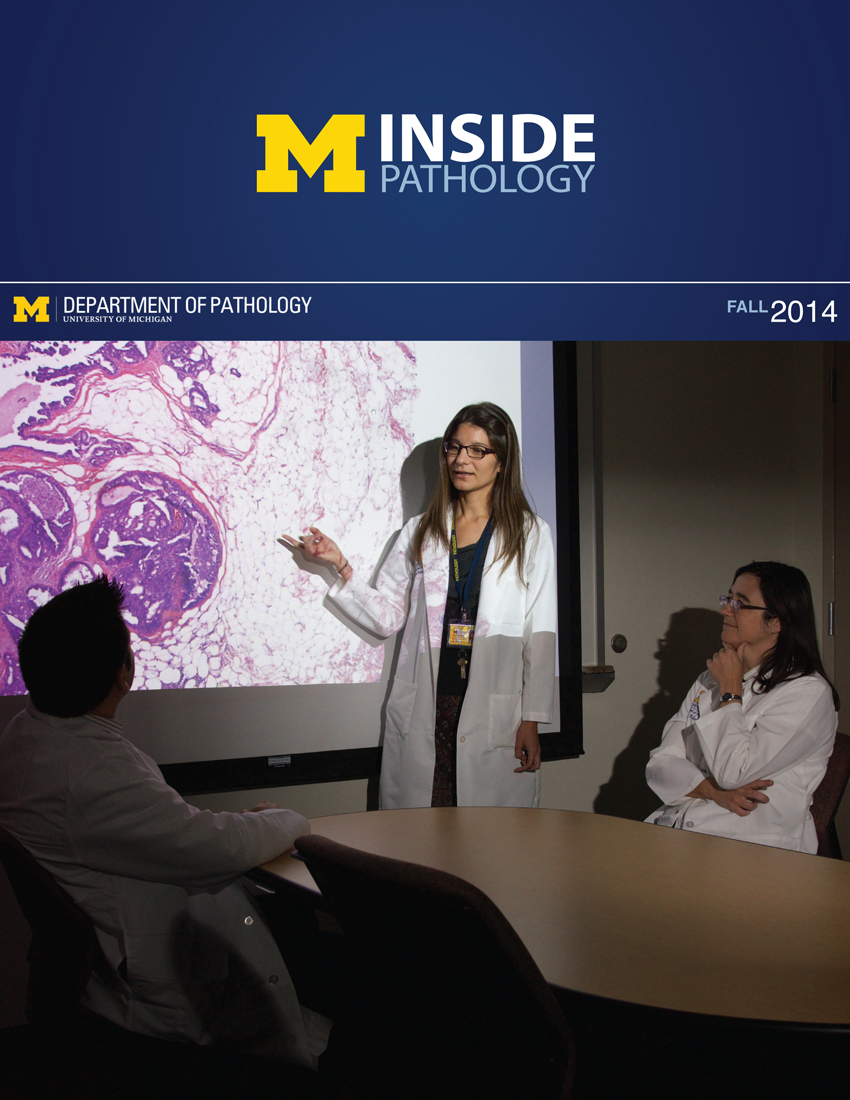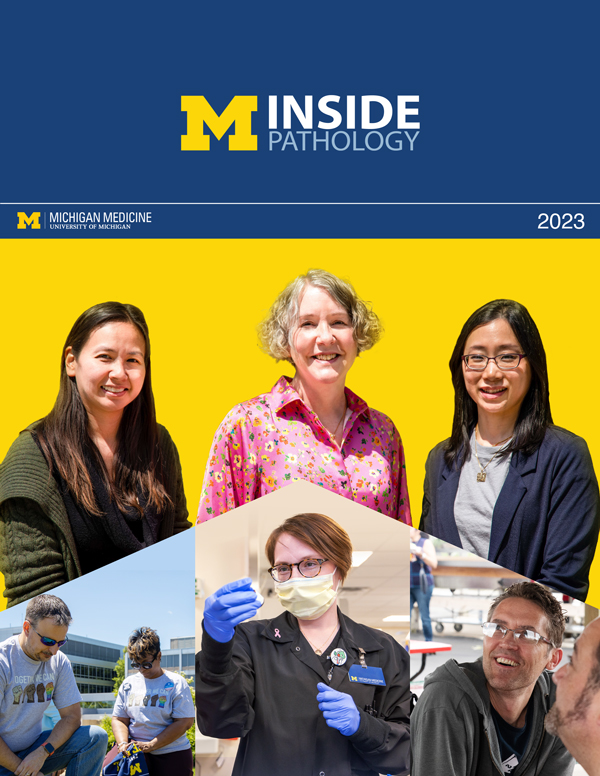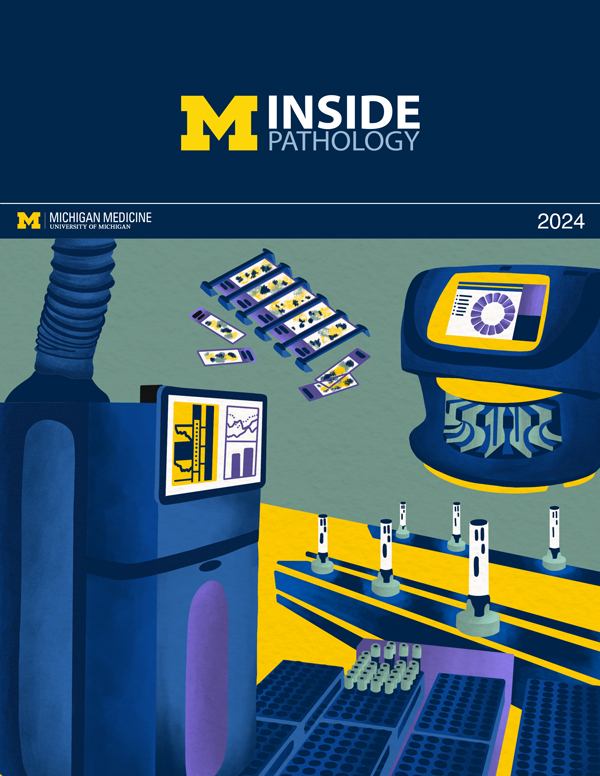


By Ian Demsky | 16 January | labblog.uofmhealth.org/lab-report
How do a couple of universally expressed proteins in stem cells and developing embryos influence an individual cell’s ultimate fate — whether it ultimately becomes, for example, a retinal cell, a heart muscle cell, or a stomach lining cell?
That’s the question that Rajesh C. Rao, MD, and his colleagues at the University of Michigan set out to answer.
Their findings, published in Cell Reports, could lead to new tools for researchers studying different types of specialized cells — for which U-M was awarded provisional patents.
The research may also help illuminate an emerging class of anti-cancer drugs, WDR5 inhibitors — as the two proteins at the heart of the study, WDR5 and p53, have long been studied in relation to cancer, and the study sheds light on how WDR5 regulates p53, both directly and indirectly.
“Most scientists have worked to understand stem cell differentiation by looking at transcription factors and how they jump into the action at a very specific time and place,” says Rao, an assistant professor of ophthalmology and pathology at Michigan Medicine, and the study’s senior author.
“Our main interest is in epigenetics and how changes in chromatin — the packaging of DNA with proteins known as histones — affect the fate of stem cells,” adds Rao, who is also the Leonard G. Miller Professor of Ophthalmology & Visual Sciences. “How does a ubiquitous transcription factor like p53 integrate time-sensitive inputs from WDR5, which is involved in chromatin modifications, to guide differentiation?”
"When we looked through the microscope, we could see the cells beating. It was a total surprise."
 And while the detailed answer to that question is primarily of interest to other scientists, what the team observed in the lab is striking.
And while the detailed answer to that question is primarily of interest to other scientists, what the team observed in the lab is striking.
Using mouse embryonic stem cells — which the researchers work with because of their rapid propensity to differentiate into specific tissues within structures called “organoids” — the researchers found that by inducing a short delay in when WDR5 was expressed in precursor cells that emerge from embryonic stem cells, they could radically change their fate.
Normally these cells would develop into proto-nervous system tissue — called the neuroectoderm — which eventually gives rise to brain, spinal cord and retinal cells. (Rao studies the epigenetic regulation of retinal development and disease.) But the scientists’ timing change of expression of the WDR5 gene steered them toward the mesoderm, which gives rise to blood cells, heart muscle cells and skeletal muscle cells.
“When we looked through the microscope, we could see the cells beating. It was a total surprise,” says Rao, who is also a member of the U-M Rogel Cancer Center and director of retina service at the VA Ann Arbor Healthcare System. “We cut them open and stained for proteins that are expressed in heart muscle cells, and found that 30-40% of the cells within the organoid had them. And that was enough for them to beat.”
Typically, researchers have to use more complex and expensive methods to generate heart-like cells from embryonic stem cells — which led the team to seek patents on generating these “organoids,” Rao explains.
More broadly, while p53 has been extensively studied in the context of cancer, the research fills in new details about the transcription factor’s role in the fate of non-cancerous embryonic cells, he adds.
“The method we used is not the way these different cell types are actually created in nature since WDR5 is not ‘naturally’ turned off temporarily in the embryo,” Rao says. “But we were trying to find out the effects of this important epigenetic player, WDR5, on differentiation that couldn’t be studied before — because if you turn it off entirely, the cells just die. So we had to devise a method to turn it off temporarily.”
Meanwhile, approaches to inhibiting WDR5 to treat cancer is the focus of $1 billion in pharmaceutical industry investment, Rao and his colleagues note, and the research could inform the investigations of off-target effects of these new potential anti-cancer drugs.
The research was supported by the National Cancer Institute grant to the U-M Rogel Cancer Center (P30CA046592), National Eye Institute (K08EY026654), Research to Prevent Blindness, the Beatrice & Reymont Paul Foundation, March Hoops to Beat Blindness, the U-M Taubman Institute, and the U-M Kellogg Eye Center. Additional support for this research was from the Leonard G. Miller Endowed Professorship and Ophthalmic Research Fund at the Kellogg Eye Center, and Grossman, Elaine Sandman, Marek and Maria Spatz, Greenspon, Dunn, Avers, Boustikakis, Sweiden, and Terauchi Research Funds.
Additional authors on the study include Qiang Li, Fengbiao Mao, Bo Zhou, Yuanhao Huang, Zhenhua Zou, Aaron D. DenDekker, Jing Xu, Sean Hou, Jie Liu and Yali Dou, all of U-M.
Disclosure: Portions of the research were used as the basis for provisional U.S. and international patent applications.
Paper cited: “p53 Integrates Temporal WDR5 Inputs during Neuroectoderm and Mesoderm Differentiation of Mouse Embryonic Stem Cells,” Cell Reports. DOI: 10.1016/j.celrep.2019.12.039
—
This story was written by Ian Demsky and originally appeared in the Michigan Medicine Health Lab Blog on 1/13/2020.
 ON THE COVER
ON THE COVER
Breast team reviewing a patient's slide. (From left to right) Ghassan Allo, Fellow; Laura Walters, Clinical Lecturer; Celina Kleer, Professor. See Article 2014Department Chair |

newsletter
INSIDE PATHOLOGYAbout Our NewsletterInside Pathology is an newsletter published by the Chairman's Office to bring news and updates from inside the department's research and to become familiar with those leading it. It is our hope that those who read it will enjoy hearing about those new and familiar, and perhaps help in furthering our research. CONTENTS
|
 ON THE COVER
ON THE COVER
Autopsy Technician draws blood while working in the Wayne County morgue. See Article 2016Department Chair |

newsletter
INSIDE PATHOLOGYAbout Our NewsletterInside Pathology is an newsletter published by the Chairman's Office to bring news and updates from inside the department's research and to become familiar with those leading it. It is our hope that those who read it will enjoy hearing about those new and familiar, and perhaps help in furthering our research. CONTENTS
|
 ON THE COVER
ON THE COVER
Dr. Sriram Venneti, MD, PhD and Postdoctoral Fellow, Chan Chung, PhD investigate pediatric brain cancer. See Article 2017Department Chair |

newsletter
INSIDE PATHOLOGYAbout Our NewsletterInside Pathology is an newsletter published by the Chairman's Office to bring news and updates from inside the department's research and to become familiar with those leading it. It is our hope that those who read it will enjoy hearing about those new and familiar, and perhaps help in furthering our research. CONTENTS
|
 ON THE COVER
ON THE COVER
Director of the Neuropathology Fellowship, Dr. Sandra Camelo-Piragua serves on the Patient and Family Advisory Council. 2018Department Chair |

newsletter
INSIDE PATHOLOGYAbout Our NewsletterInside Pathology is an newsletter published by the Chairman's Office to bring news and updates from inside the department's research and to become familiar with those leading it. It is our hope that those who read it will enjoy hearing about those new and familiar, and perhaps help in furthering our research. CONTENTS
|
 ON THE COVER
ON THE COVER
Residents Ashley Bradt (left) and William Perry work at a multi-headed scope in our new facility. 2019Department Chair |

newsletter
INSIDE PATHOLOGYAbout Our NewsletterInside Pathology is an newsletter published by the Chairman's Office to bring news and updates from inside the department's research and to become familiar with those leading it. It is our hope that those who read it will enjoy hearing about those new and familiar, and perhaps help in furthering our research. CONTENTS
|
 ON THE COVER
ON THE COVER
Dr. Kristine Konopka (right) instructing residents while using a multi-headed microscope. 2020Department Chair |

newsletter
INSIDE PATHOLOGYAbout Our NewsletterInside Pathology is an newsletter published by the Chairman's Office to bring news and updates from inside the department's research and to become familiar with those leading it. It is our hope that those who read it will enjoy hearing about those new and familiar, and perhaps help in furthering our research. CONTENTS
|
 ON THE COVER
ON THE COVER
Patient specimens poised for COVID-19 PCR testing. 2021Department Chair |

newsletter
INSIDE PATHOLOGYAbout Our NewsletterInside Pathology is an newsletter published by the Chairman's Office to bring news and updates from inside the department's research and to become familiar with those leading it. It is our hope that those who read it will enjoy hearing about those new and familiar, and perhaps help in furthering our research. CONTENTS
|
 ON THE COVER
ON THE COVER
Dr. Pantanowitz demonstrates using machine learning in analyzing slides. 2022Department Chair |

newsletter
INSIDE PATHOLOGYAbout Our NewsletterInside Pathology is an newsletter published by the Chairman's Office to bring news and updates from inside the department's research and to become familiar with those leading it. It is our hope that those who read it will enjoy hearing about those new and familiar, and perhaps help in furthering our research. CONTENTS
|
 ON THE COVER
ON THE COVER
(Left to Right) Drs. Angela Wu, Laura Lamps, and Maria Westerhoff. 2023Department Chair |

newsletter
INSIDE PATHOLOGYAbout Our NewsletterInside Pathology is an newsletter published by the Chairman's Office to bring news and updates from inside the department's research and to become familiar with those leading it. It is our hope that those who read it will enjoy hearing about those new and familiar, and perhaps help in furthering our research. CONTENTS
|
 ON THE COVER
ON THE COVER
Illustration representing the various machines and processing used within our labs. 2024Department Chair |

newsletter
INSIDE PATHOLOGYAbout Our NewsletterInside Pathology is an newsletter published by the Chairman's Office to bring news and updates from inside the department's research and to become familiar with those leading it. It is our hope that those who read it will enjoy hearing about those new and familiar, and perhaps help in furthering our research. CONTENTS
|

MLabs, established in 1985, functions as a portal to provide pathologists, hospitals. and other reference laboratories access to the faculty, staff and laboratories of the University of Michigan Health System’s Department of Pathology. MLabs is a recognized leader for advanced molecular diagnostic testing, helpful consultants and exceptional customer service.